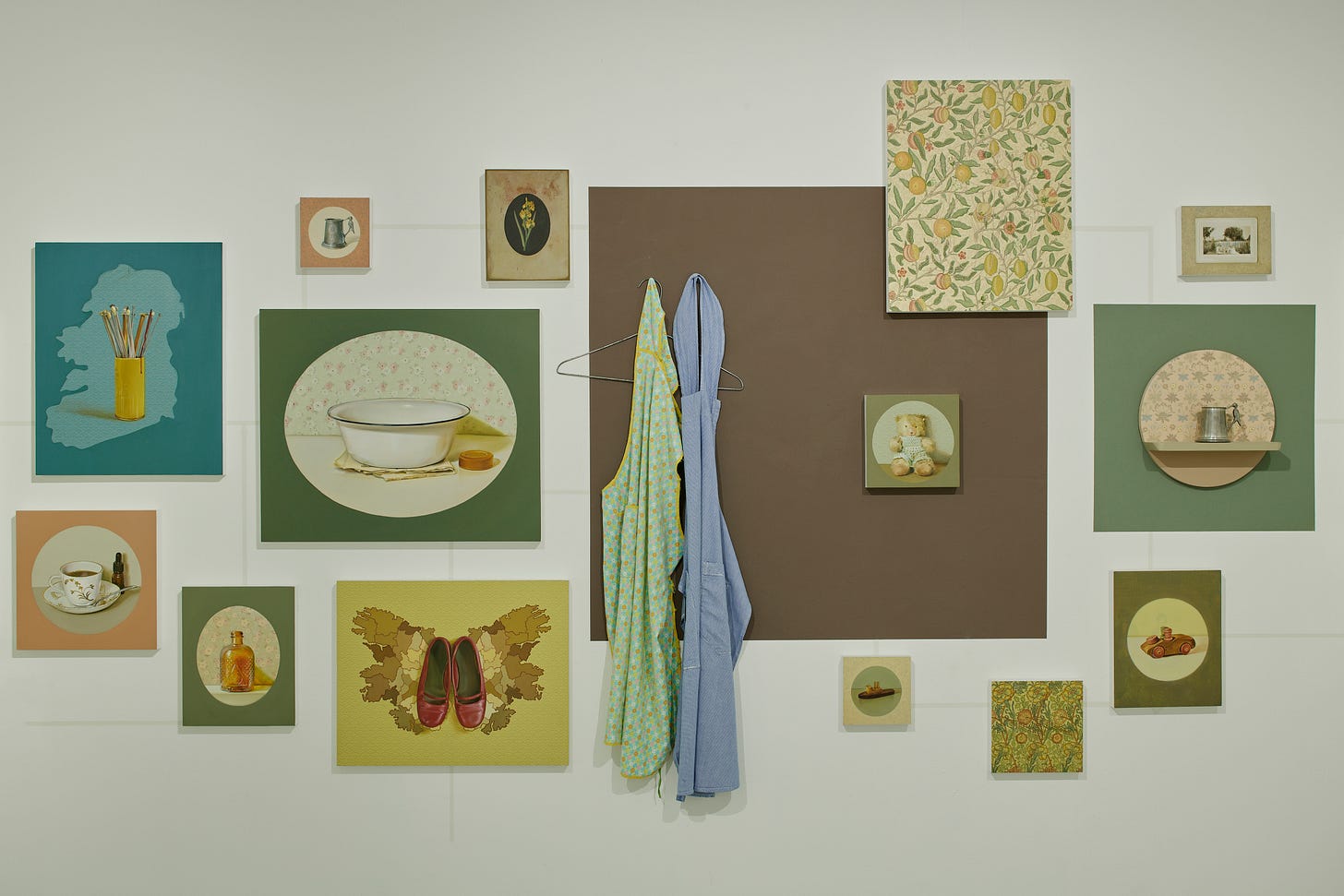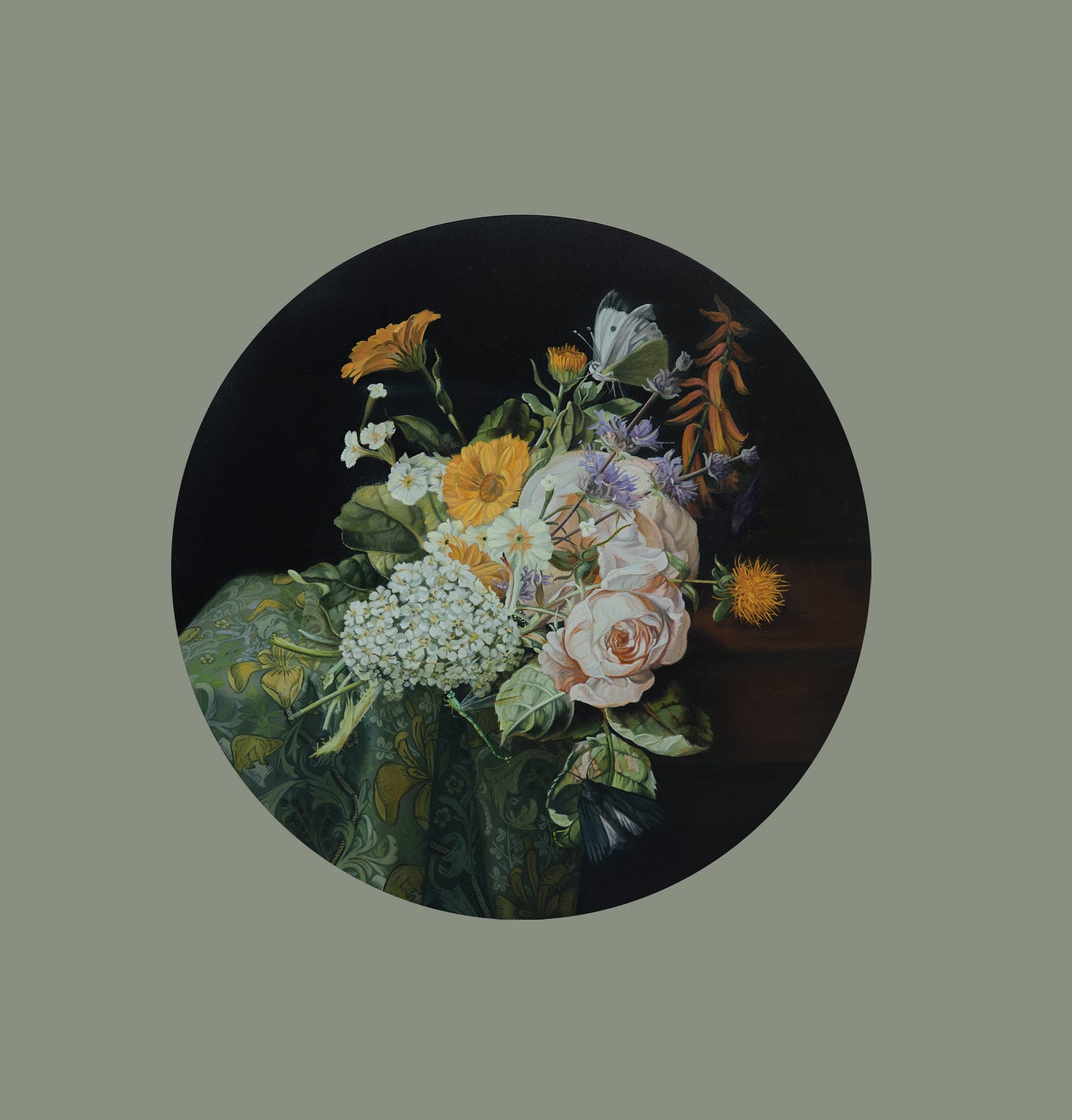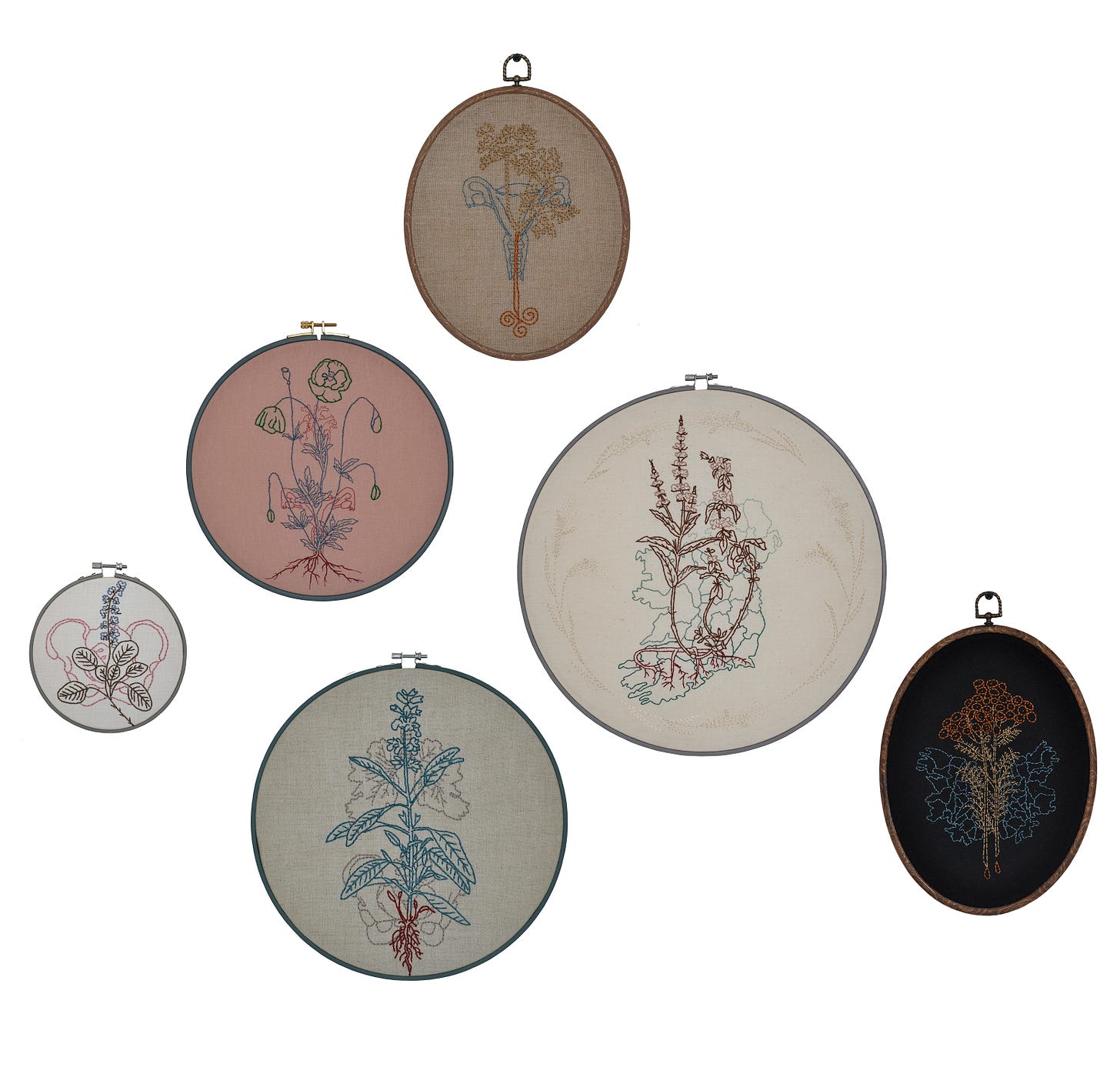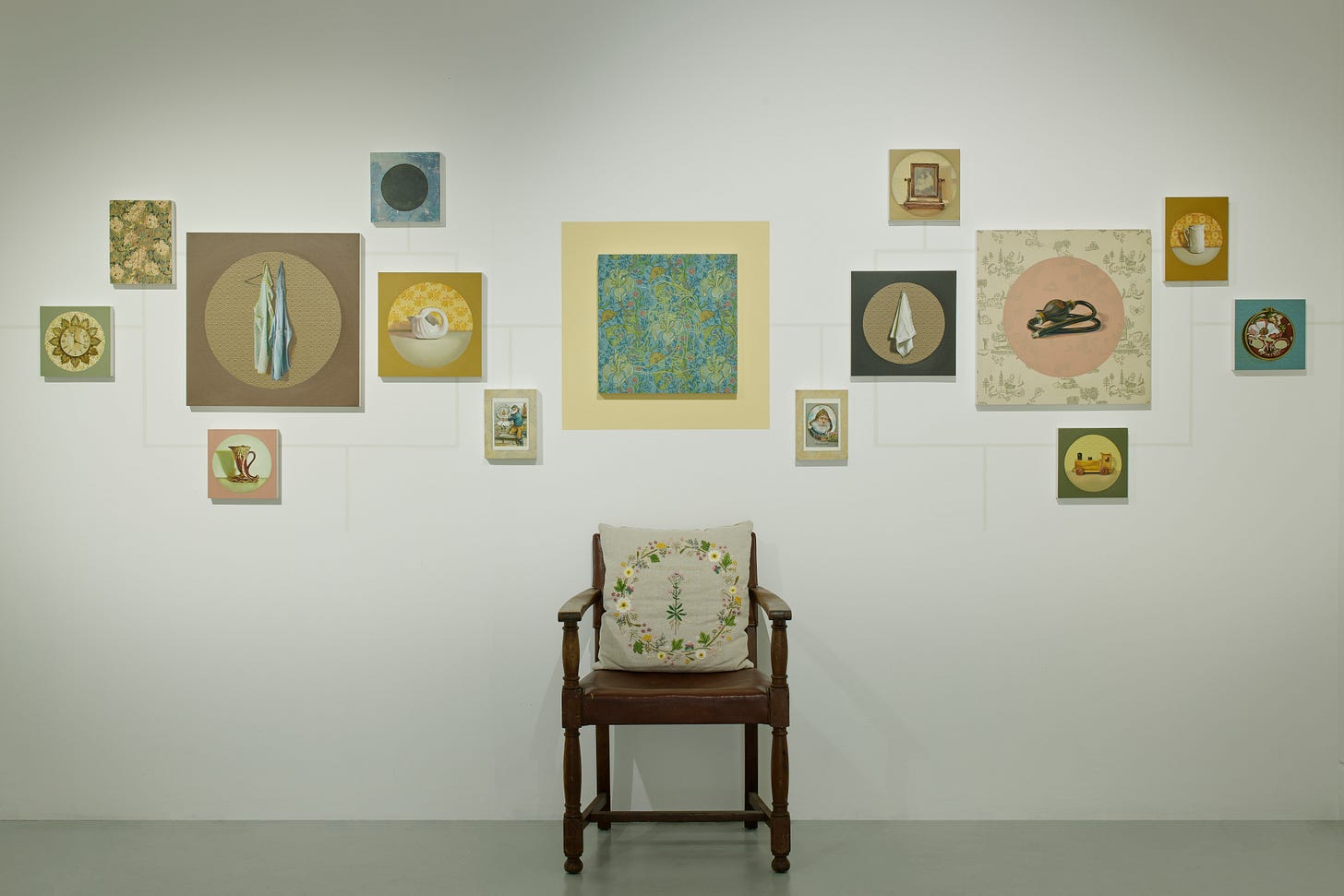One of Many
The quiet activism of Jennifer Trouton
Wandering through the halls of the Supermarket Art Fair here in Stockholm this spring, I was drawn into the calm, nostalgic, simplicity of Jennifer Trouton’s still lives, In Plain Sight. A stack of teacups, an enameled bowl, a child’s toy... I had to look deeper. Beautiful botanicals in quaint embroidery alongside a flower covered hip bone, and suddenly I realized I was looking at something much more complex and layered. The blood red fringe of stitches dripping from a map of Ireland gave me the final piece of the puzzle. The plants Trouton features are known collectively as abortifacients, recipes of which women have used for centuries to end unwanted pregnancies. Abortion rights are in the news again but the story is as old as time. Trouton’s work skillfully honors and explores the many layers, and hidden stories of a darker side of motherhood, and women’s roles in society than we are usually willing to confront.
Recently I had the opportunity to virtually tour Trouton’s studio and learn more about her work.
Karen Grace: As beautiful as it is, there is clearly a lot of research that has gone into your work and so many layers of meaning. Can you tell me about your process and some of the research that went into In Plain Sight?
Jennifer Trouton: Yes, in 2012 there was a tragedy in Ireland, one of many, unfortunately. A lady called Savita Halappanavar died in a Galway hospital after getting sepsis because the doctors wouldn't terminate her pregnancy. So that galvanized people in Ireland and there was a lot of grassroots protesting to repeal the 8th amendment. In Ireland, we had the “heartbeat law” where basically as long as there was a heartbeat, doctors wouldn’t intervene. But, you know, women's lives were lost because of it.
The same year, my husband decided to do a PhD on abortion in Northern Ireland. Because... This is so bizarre. He went into town one day, and he saw a pro-life group or anti-choice protest, and he tried to talk with them because they were displaying these absolutely horrifically graphic images in the middle of the day.
And he said, I work in television, we wouldn't be allowed to do that. What are you doing? And he tried to have this measured conversation with them. He quite quickly realized there was absolutely no reasoning with them. They said something about Northern Ireland doesn't need abortion. Women here don't want it. Which is ridiculous. Right there and then he decided to do a PhD on the subject!
It was, what do you call it? A confluence! A short while after I had my son, there was a lot of grassroots activism happening to change the law in Ireland, both North and South. And then my husband started doing the PhD, and he was coming home with all of this research. He was reading about women who often died, or ended up in very, very bad situations. The emotional weight of the stories he was reading... he was kind of overwhelmed, so he was sharing his load. And around that time, I had started getting back to my studio after I'd had my newborn. Initially I thought, I'm going to make work about motherhood, I never thought I was going to do anything about abortion. But I realized, all this was coming at me, and I was kind of dodging it because it is such an emotional and controversial subject.
And one day, I was in the studio, and whatever I was doing, I just felt: This is not what I'm supposed to be doing. In fact, I'm kind of skirting around this… looking at motherhood, the idea of Ireland and the constitution and where it places women.
It then occurred to me that I had, like so many women before and after me been silenced by the shame and stigma attached to abortion but I couldn’t be silent anymore. Yes, I had an abortion, I was forced to cross the water in 1988, a terrified 17-year-old. It was extremely traumatic, and I had never spoken about it. I realized then that this is what I should be making work about. These women's stories, which is also my story, need to be told in a sensitive, caring kind of way.
And I have that first-hand experience. I have that lived experience. And I need to make work that's going to draw people in and gently start the conversation. So, in 2015, about a year after I had my son, I started to make those tentative steps... I thought I'm going to make this work. And I'm going to use my husband's research.
He would tell me all the ways that women were using the tools of the domestic space. A lot of my practice at this point had been to do with women's lived experience, to do with my family's migration, women's work in the factories, to do with farming life... all my work has been mostly biographical… so I thought, you know what, this isn't a leap for me at all. This is almost a natural evolution.
He took four years to do his PhD and we were working in tandem. For example, the recipe of abortifacient plants that I used to create a floral wallpaper came out of his research into a 16th century female gynecologist from Italy called Trota of Salerno.
These women were kind of... stuck in the domestic space, that's all they had, so they were turning to the everyday, banal kind of objects of the home and turned them into weapons. I wanted to make this work that people looked at and had a nostalgic reaction to. It's like, oh look at this beautiful ceramic bowl, or that teacup. But, in reality, what they're looking at is something that someone’s used as a tool of their own emancipation. So, there's that duality within the work and tying it all together is the wallpaper. Putting religious imagery in the wallpaper was to suggest the pervasive nature of religion and the fact that it's almost part of the fabric of Irish society.
So, the work grew alongside the research and it's still growing. All the work I'm still doing is under that umbrella. I'm just growing with it, and even though the legislation has changed since I started, about three or four years into this process, thankfully it doesn't in any way devalue or make the work less important because these, these are women's stories. This is our history. And its history that hasn't even been acknowledged. You'll never see a museum to abortion, … it's not palatable.
So even though the legislation has changed, very little has changed, because a lot of women still don't access the services, because the government has been slow, probably deliberately, to put them in place.
And the shame and the stigma are still there. That's not something that goes away overnight. You change the law; it doesn't change people's perceptions. It doesn't change people's biased, unconscious, or even conscious views on abortion.
Absolutely. There's tons of artwork out there that's very confrontational about women's bodies and women's reproductive rights. And one of the things that I find so interesting about yours is the way that it draws the viewer in, in this very sweet and gentle way.
I feel like it really helps to build empathy, because you're thinking about, what did mothers and grandmothers, and all who came before me go through? And even in the United States, okay, technically we've had the right since Roe in ‘73, but it's constantly being chipped (or hacked) away at!
So I find that's such a refreshing way to look at it... To value these women's stories. It seems like such a simple request, to have control over their own bodies.
Well, I think going back to my husband that day in the street, I mean, his reaction to that man waving placards of supposedly aborted fetuses wasn’t the reaction the man wanted. I think for me, I want everybody to be able to engage with the work, I don’t want to just preach to the choir.
We have a political party here called the DUP, they're very conservative and completely anti-choice. I always said I wanted to make work that they would be attracted to. They'd be drawn-in, they'd walk into a gallery and walk over and go isn't that beautiful and then hopefully then have their ideas challenged.
For me the beauty of hiding it within that layer of aesthetic also plays into this idea of how we romanticize the idea of the home and motherhood. Everything is warm and cozy and nostalgic and beautiful. The wallpapers I choose are all very harmonious and wholesome. I heavily edit and anything that doesn't sit right, it gets pulled out.
We hid our women in the domestic space, we shoved all their issues under the carpet, we ignored, we overlooked, and we just nullified them and fooled ourselves with this idea that All women are wholesome. The home is a place of safety. The home is a place of comfort. But the reality is it's one of the most violent places on earth.
And the most dangerous for women. Most women die in the home, you know! I'm deliberately peddling that nostalgic aesthetic and going, look, this is what we think of the home and what we think of motherhood. Lovely subdued, nostalgic, 1950s-esque colors. Objects that are very emotive, that make you think of your grandparents or your mother.
But there's such a dark undercurrent to it, so that's the thing, we have allowed ourselves to be lulled into thinking the home is always a safe place, and it's where women should be.
We tell ourselves the story that women should be able to keep the surface all perfect and beautiful while they juggle all of these deeper, darker things, but maintain the facade, maintain the ability to keep everybody warm and fed. Everybody loves being at home and yet there's lots of things that are brewing beneath the surface.
And that's an illusion the church and state peddle. In Ireland, they actually wrote it into the constitution that the men should go out and provide for the women, the women shouldn't need to go out. In the constitution! Even though up until that point, women had been out in the streets fighting for the country, they were part of the uprising.
But once the partition happened, the Irish state wrote women back into the home. So, it's not even just society in general. Our state and our church, two of the most controlling sectors of society, put women there, and they made people think that's where they should be. And they treat them like second class citizens.
Oh yes, even in the United States, there's still no statement of women's equality in the constitution. It's still not there. In so many ways we're still so far behind. It's shocking, isn't it? So much work to do.
Yeah. And it feels like the hill's getting steeper instead of flatter. It does! It feels like we're traveling backwards instead of forwards in so many ways. I mean, I often think it's a luxury what I do, being an artist, and I know that I'm not going to change the world, but at least I hopefully will be part of a conversation. I’ve had women write to me and say, I came to your show, and I brought my daughter. I mean, it was uncomfortable, but you know, we ended up having a conversation and I'm thinking, well, that's a little small victory and those small victories add up to bigger victories. You know, I call myself a quiet activist. I'm not out on the streets. I'm not a public speaker, you know, but I'm doing my own form of activism for myself for my own personal reasons, but I hope at least I'm adding to the conversation.
Have you had any negative responses?
No. I haven't really... the closest I came was in Stockholm where there was a lady, I think she was Greek, and she was not pro-choice. She came and spoke to me with her daughter who translated, but it was a really respectful conversation.
She was very drawn to and moved by the work. The daughter told me she was anti-abortion because she had had one when she was younger and it turned out to be twins and it had completely traumatized her.
But she was actually very respectful and said how much she liked my work and it really touched her. So even though she was against it, she was very respectful. But then again, who knows what the reaction will be in the future when the work goes out to other places?
I've done a few public talks, at different exhibitions, and nearly every time I broke down because every single time I've ended up talking about the title being One of Many, and that I am One of the Many. … and about these women's experiences, these women who died, and their stories that are lost in archives. They're not being talked about, they're not being recognized. I always end up in tears.
Major institutions have bought pieces of the work in the last two years, which I don't think would have happened if it had been visceral angry work, if that makes sense. I'm angry. I'm very, very angry. My anger is very much within the work, but I'm not making visually angry work.
Oh yes, I think it's such an important role of art to help people have empathy for other people. And even if you don't agree, but how to understand somebody else's story and why they might make the choices that they make. And I think that your work is doing an incredible job at building empathy, like the one you just had in an exhibition, with the chair in the corner around the darkness. And it's like you’re invited to sit down and hear this story. Sit down and understand.
You have a mother, you have a sister, you are part of the conversation, you're part of the story. When the lighting hits the mirror hanging above the chair, it creates a spotlight on the ground that kind of invites you to stand on it and look in the mirror. And then you become one of many.
I like that intergenerational aspect as well. The work draws in people who, look at it and go, well, my grandmother had that object in her house, and then they stop and think about it, Jesus, what did my grandmother go through? What did my mother go through?
What have we allowed the women in our history, in our past, to go through? It's just heartbreaking. Some of the stories are just so brutal what these women did to themselves. And then the aftermath. They didn't die. They ended up in court. They ended up ostracized by society. Some of them ended up taking their own lives. Such a lot of heartbreak.
We don't want to talk about it. We don't want to make a plaque or have a museum or have a memorial. So, at least in some small way, I can bring some of that out into the public domain to be heard. I can't use the women’s names, but it doesn't really matter, it's not about names, it's all a collective story. It's about every woman.
You're doing a beautiful job of memorializing these women's lives and their stories. And helping us learn to talk about it in different ways. Thank you so very much.
You can see more of Jennifer Trouton’s work here on her website and all this month right here on Tarantula. Keep up with her here on Instagram.








As with many issues today, I wish there could be more respectful conversations and less shouting.